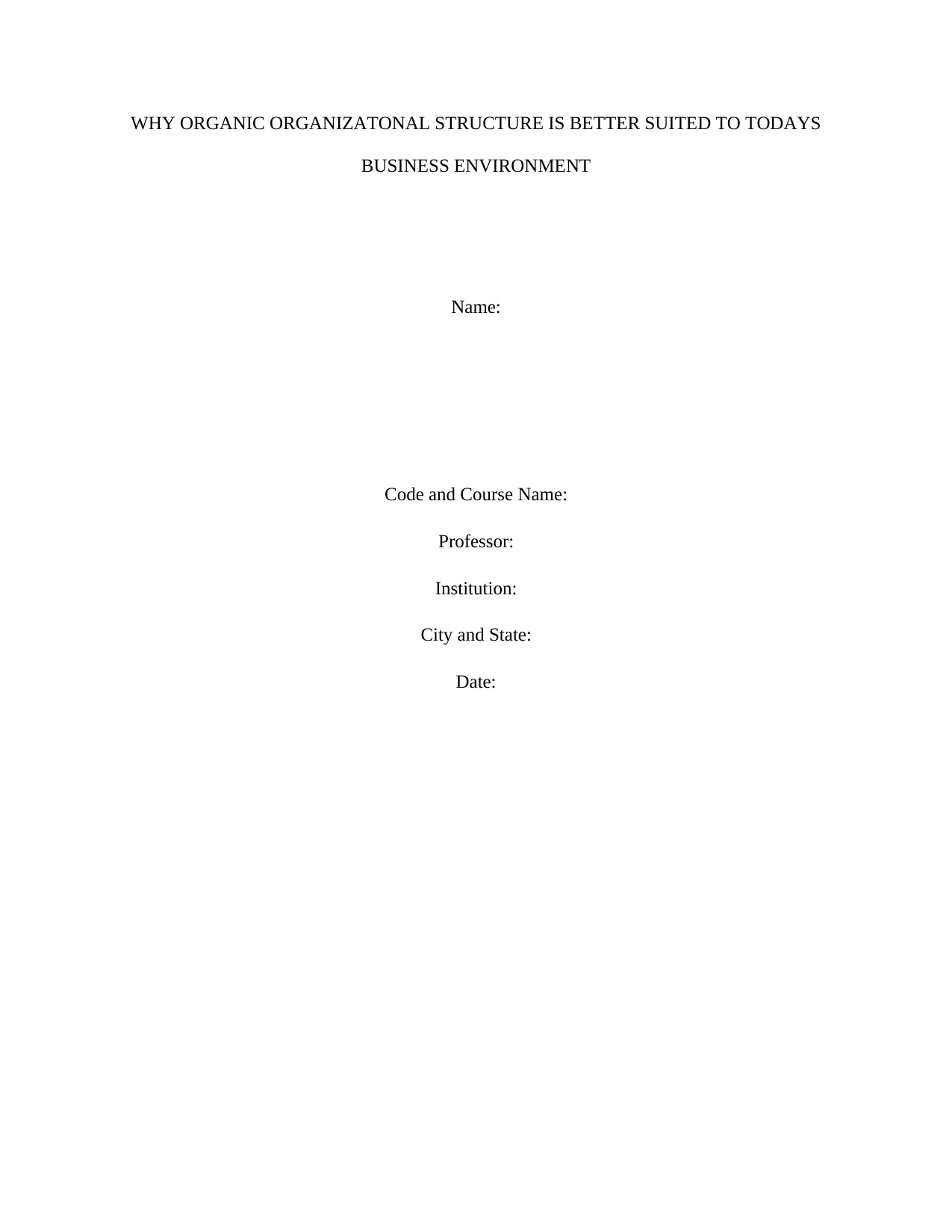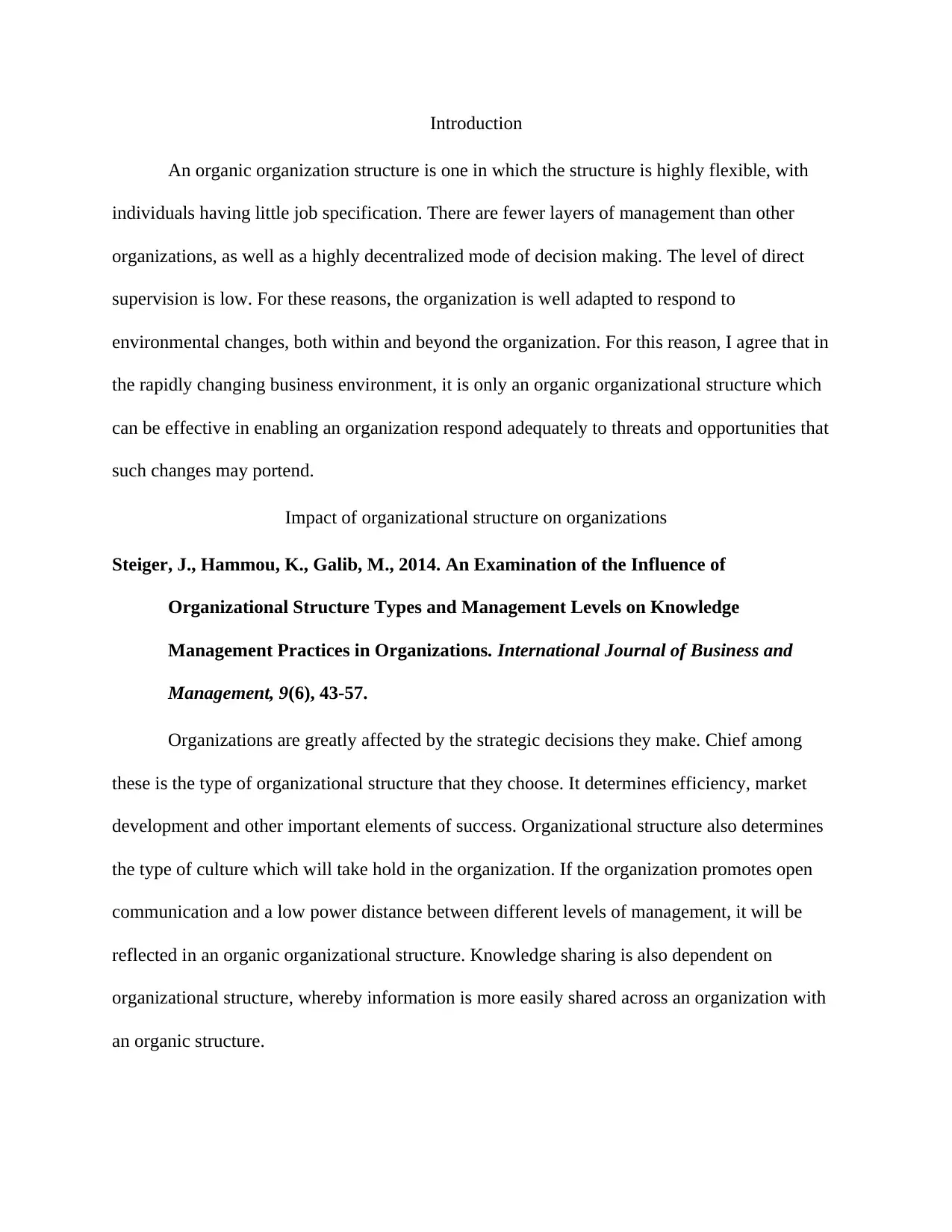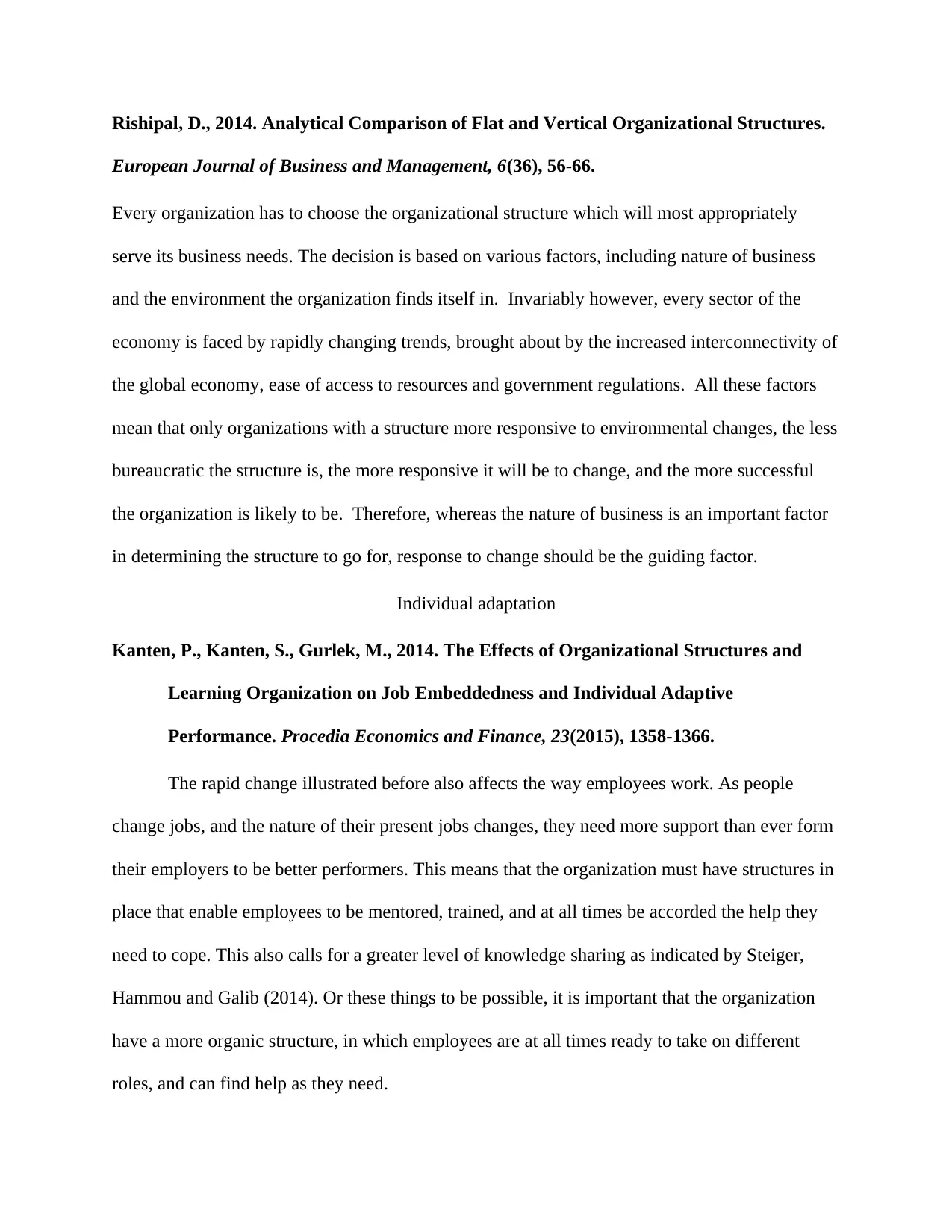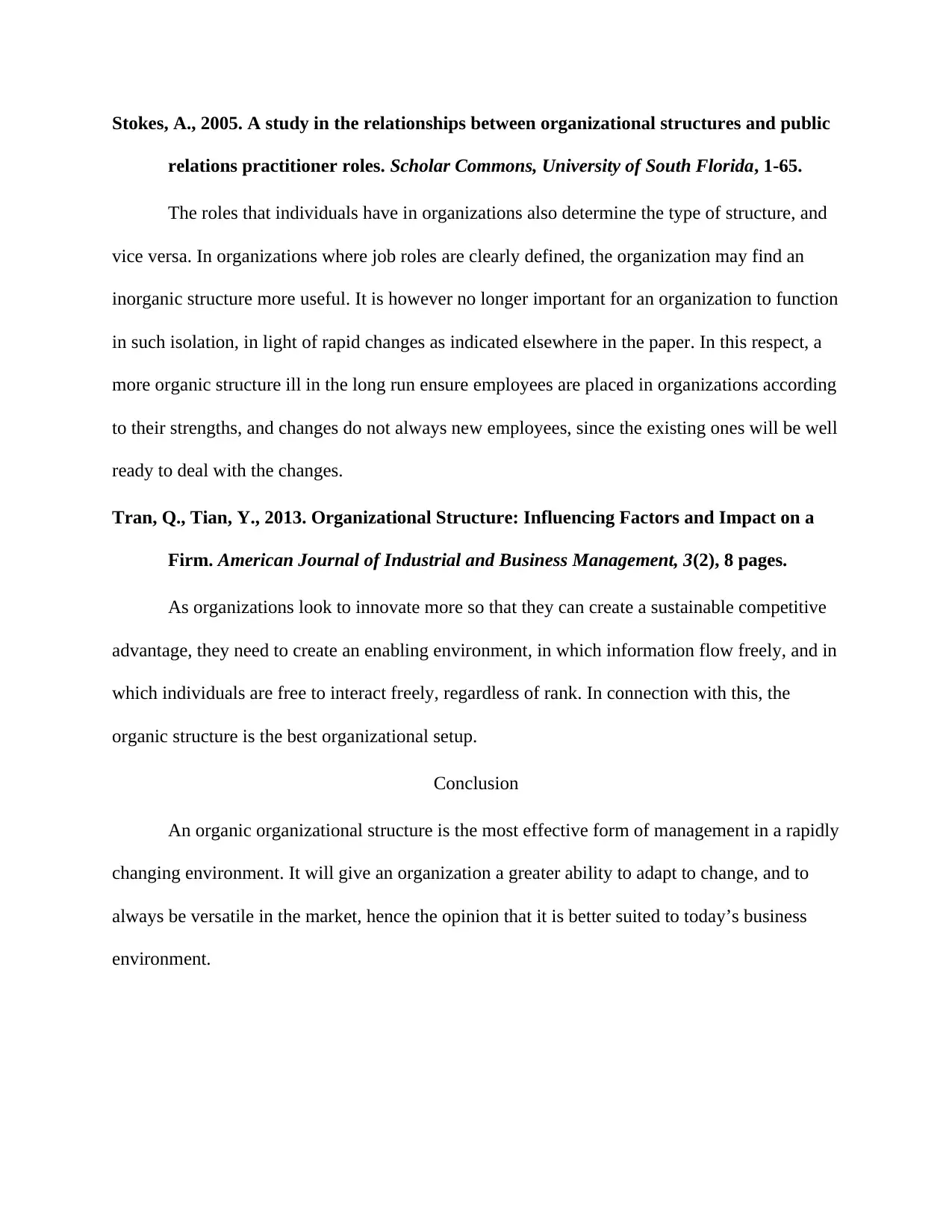The Advantages of Organic Organizational Structure in the Modern Era
VerifiedAdded on 2020/03/07
|4
|940
|293
Essay
AI Summary
This essay argues for the superiority of organic organizational structures in the contemporary business landscape. It begins by defining organic structures, which are characterized by flexibility, decentralized decision-making, and minimal job specialization, making them highly responsive to environmental changes. The essay then explores the impact of organizational structure on efficiency, market development, and company culture, emphasizing how organic structures foster open communication and knowledge sharing. It also highlights how organic structures facilitate individual adaptation and employee development by promoting mentoring, training, and knowledge sharing, essential for navigating rapid changes in the modern workplace. The essay concludes by reiterating the organic structure's effectiveness in fostering adaptability and versatility, making it ideally suited for today's dynamic business environment.

WHY ORGANIC ORGANIZATONAL STRUCTURE IS BETTER SUITED TO TODAYS
BUSINESS ENVIRONMENT
Name:
Code and Course Name:
Professor:
Institution:
City and State:
Date:
BUSINESS ENVIRONMENT
Name:
Code and Course Name:
Professor:
Institution:
City and State:
Date:
Paraphrase This Document
Need a fresh take? Get an instant paraphrase of this document with our AI Paraphraser

Introduction
An organic organization structure is one in which the structure is highly flexible, with
individuals having little job specification. There are fewer layers of management than other
organizations, as well as a highly decentralized mode of decision making. The level of direct
supervision is low. For these reasons, the organization is well adapted to respond to
environmental changes, both within and beyond the organization. For this reason, I agree that in
the rapidly changing business environment, it is only an organic organizational structure which
can be effective in enabling an organization respond adequately to threats and opportunities that
such changes may portend.
Impact of organizational structure on organizations
Steiger, J., Hammou, K., Galib, M., 2014. An Examination of the Influence of
Organizational Structure Types and Management Levels on Knowledge
Management Practices in Organizations. International Journal of Business and
Management, 9(6), 43-57.
Organizations are greatly affected by the strategic decisions they make. Chief among
these is the type of organizational structure that they choose. It determines efficiency, market
development and other important elements of success. Organizational structure also determines
the type of culture which will take hold in the organization. If the organization promotes open
communication and a low power distance between different levels of management, it will be
reflected in an organic organizational structure. Knowledge sharing is also dependent on
organizational structure, whereby information is more easily shared across an organization with
an organic structure.
An organic organization structure is one in which the structure is highly flexible, with
individuals having little job specification. There are fewer layers of management than other
organizations, as well as a highly decentralized mode of decision making. The level of direct
supervision is low. For these reasons, the organization is well adapted to respond to
environmental changes, both within and beyond the organization. For this reason, I agree that in
the rapidly changing business environment, it is only an organic organizational structure which
can be effective in enabling an organization respond adequately to threats and opportunities that
such changes may portend.
Impact of organizational structure on organizations
Steiger, J., Hammou, K., Galib, M., 2014. An Examination of the Influence of
Organizational Structure Types and Management Levels on Knowledge
Management Practices in Organizations. International Journal of Business and
Management, 9(6), 43-57.
Organizations are greatly affected by the strategic decisions they make. Chief among
these is the type of organizational structure that they choose. It determines efficiency, market
development and other important elements of success. Organizational structure also determines
the type of culture which will take hold in the organization. If the organization promotes open
communication and a low power distance between different levels of management, it will be
reflected in an organic organizational structure. Knowledge sharing is also dependent on
organizational structure, whereby information is more easily shared across an organization with
an organic structure.

Rishipal, D., 2014. Analytical Comparison of Flat and Vertical Organizational Structures.
European Journal of Business and Management, 6(36), 56-66.
Every organization has to choose the organizational structure which will most appropriately
serve its business needs. The decision is based on various factors, including nature of business
and the environment the organization finds itself in. Invariably however, every sector of the
economy is faced by rapidly changing trends, brought about by the increased interconnectivity of
the global economy, ease of access to resources and government regulations. All these factors
mean that only organizations with a structure more responsive to environmental changes, the less
bureaucratic the structure is, the more responsive it will be to change, and the more successful
the organization is likely to be. Therefore, whereas the nature of business is an important factor
in determining the structure to go for, response to change should be the guiding factor.
Individual adaptation
Kanten, P., Kanten, S., Gurlek, M., 2014. The Effects of Organizational Structures and
Learning Organization on Job Embeddedness and Individual Adaptive
Performance. Procedia Economics and Finance, 23(2015), 1358-1366.
The rapid change illustrated before also affects the way employees work. As people
change jobs, and the nature of their present jobs changes, they need more support than ever form
their employers to be better performers. This means that the organization must have structures in
place that enable employees to be mentored, trained, and at all times be accorded the help they
need to cope. This also calls for a greater level of knowledge sharing as indicated by Steiger,
Hammou and Galib (2014). Or these things to be possible, it is important that the organization
have a more organic structure, in which employees are at all times ready to take on different
roles, and can find help as they need.
European Journal of Business and Management, 6(36), 56-66.
Every organization has to choose the organizational structure which will most appropriately
serve its business needs. The decision is based on various factors, including nature of business
and the environment the organization finds itself in. Invariably however, every sector of the
economy is faced by rapidly changing trends, brought about by the increased interconnectivity of
the global economy, ease of access to resources and government regulations. All these factors
mean that only organizations with a structure more responsive to environmental changes, the less
bureaucratic the structure is, the more responsive it will be to change, and the more successful
the organization is likely to be. Therefore, whereas the nature of business is an important factor
in determining the structure to go for, response to change should be the guiding factor.
Individual adaptation
Kanten, P., Kanten, S., Gurlek, M., 2014. The Effects of Organizational Structures and
Learning Organization on Job Embeddedness and Individual Adaptive
Performance. Procedia Economics and Finance, 23(2015), 1358-1366.
The rapid change illustrated before also affects the way employees work. As people
change jobs, and the nature of their present jobs changes, they need more support than ever form
their employers to be better performers. This means that the organization must have structures in
place that enable employees to be mentored, trained, and at all times be accorded the help they
need to cope. This also calls for a greater level of knowledge sharing as indicated by Steiger,
Hammou and Galib (2014). Or these things to be possible, it is important that the organization
have a more organic structure, in which employees are at all times ready to take on different
roles, and can find help as they need.
⊘ This is a preview!⊘
Do you want full access?
Subscribe today to unlock all pages.

Trusted by 1+ million students worldwide

Stokes, A., 2005. A study in the relationships between organizational structures and public
relations practitioner roles. Scholar Commons, University of South Florida, 1-65.
The roles that individuals have in organizations also determine the type of structure, and
vice versa. In organizations where job roles are clearly defined, the organization may find an
inorganic structure more useful. It is however no longer important for an organization to function
in such isolation, in light of rapid changes as indicated elsewhere in the paper. In this respect, a
more organic structure ill in the long run ensure employees are placed in organizations according
to their strengths, and changes do not always new employees, since the existing ones will be well
ready to deal with the changes.
Tran, Q., Tian, Y., 2013. Organizational Structure: Influencing Factors and Impact on a
Firm. American Journal of Industrial and Business Management, 3(2), 8 pages.
As organizations look to innovate more so that they can create a sustainable competitive
advantage, they need to create an enabling environment, in which information flow freely, and in
which individuals are free to interact freely, regardless of rank. In connection with this, the
organic structure is the best organizational setup.
Conclusion
An organic organizational structure is the most effective form of management in a rapidly
changing environment. It will give an organization a greater ability to adapt to change, and to
always be versatile in the market, hence the opinion that it is better suited to today’s business
environment.
relations practitioner roles. Scholar Commons, University of South Florida, 1-65.
The roles that individuals have in organizations also determine the type of structure, and
vice versa. In organizations where job roles are clearly defined, the organization may find an
inorganic structure more useful. It is however no longer important for an organization to function
in such isolation, in light of rapid changes as indicated elsewhere in the paper. In this respect, a
more organic structure ill in the long run ensure employees are placed in organizations according
to their strengths, and changes do not always new employees, since the existing ones will be well
ready to deal with the changes.
Tran, Q., Tian, Y., 2013. Organizational Structure: Influencing Factors and Impact on a
Firm. American Journal of Industrial and Business Management, 3(2), 8 pages.
As organizations look to innovate more so that they can create a sustainable competitive
advantage, they need to create an enabling environment, in which information flow freely, and in
which individuals are free to interact freely, regardless of rank. In connection with this, the
organic structure is the best organizational setup.
Conclusion
An organic organizational structure is the most effective form of management in a rapidly
changing environment. It will give an organization a greater ability to adapt to change, and to
always be versatile in the market, hence the opinion that it is better suited to today’s business
environment.
1 out of 4
Related Documents
Your All-in-One AI-Powered Toolkit for Academic Success.
+13062052269
info@desklib.com
Available 24*7 on WhatsApp / Email
![[object Object]](/_next/static/media/star-bottom.7253800d.svg)
Unlock your academic potential
Copyright © 2020–2025 A2Z Services. All Rights Reserved. Developed and managed by ZUCOL.




